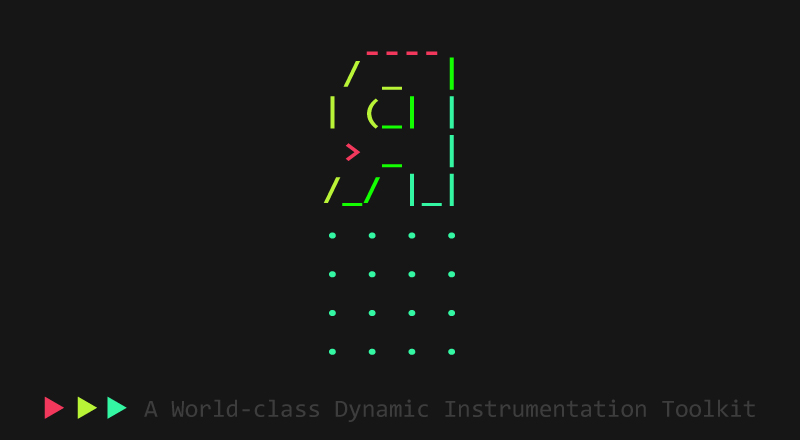Dynamic Instrumentation Toolkit – Frida

Introduction
Frida is a free and open-source dynamic instrumentation toolkit, that allows developers, reverse-engineers, and security researchers to monitor and debug running processes. It also enables programmers, software and security professionals to execute their own JS scripts into other processes running on:
- Windows, Linux, Android, iOS or macOS.
Frida: A World Class Dynamic Instrumentation Toolkit
It lets you inject snippets of JavaScript into native apps on Windows, Mac, Linux, iOS and Android. Frida also provides you with some simple tools built on top of the Frida API.
In other words, it allows you to inject your own code and to programmatically and interactively inspect and change running processes. Frida doesn’t need access to source code and can be used on iOS and Android devices that aren’t jailbroken or rooted. It lets you do all of this through APIs available from Objective-C, which are also exposed to higher-level languages through bindings.
Features:
- Scriptable: You can inject your own scripts into black box processes to execute custom debugging logic. Hook any function, spy on crypto APIs or trace private application code, no source code needed.
- Multi-platform (portable): Works on Windows, macOS, GNU/Linux, iOS, Android, and QNX (
Node.jsbinding, Python package fromPyPI,Swiftbindings,.NETbindings,Qt/Qmlbindings, orCAPI). - Battle-tested: It has a comprehensive test-suite and has gone through years of rigorous testing across a broad range of use-cases.
- Free and open-source: Frida is and will always be free software.
Frida Toolkit
Frida CLI: REPL interface that aims to emulate a lot of the nice features of IPython (or Cycript), which tries to get you closer to your code for rapid prototyping and easy debugging.frida-ps: command-line tool for listing processes (very useful when interacting with a remote system).frida-trace: tool for dynamically tracing function calls.frida-discover: tool for discovering internal functions in a program, which can then be traced by usingfrida-trace.frida-ls-devices: command-line tool for listing attached devices (very useful when interacting with multiple devices).frida-kill: command-line tool for killing processes.
Operation modes
Frida provides dynamic instrumentation through its instrumentation core Gum, written in C. With few lines of C you can run a piece of JavaScript inside a runtime that has full access to Gum’s APIs. That allows you to hook functions, enumerate loaded libraries (their imported and exported functions), read and write memory, scan memory for patterns, etc.
- Injected:
- Spawn an existing program (create and execute child process)
- Hijack a process when its spawned
- Attach/Hooking to running program
- Requires Root/Admin priv
- Embedded:
- Useful in non-jailbroken iOS / non-root Android (
frida-gadgetlibrary)
- Useful in non-jailbroken iOS / non-root Android (
- Preloaded
r2frida: Radare2 and Frida better together
Install
Requirements for Frida’s CLI tools:
Python 3.x+- GNU/Linux, Windows or macOS
Install with pip:
$ pip install frida-tools # CLI tools $ pip install frida # Python bindings $ npm install frida # Node.js bindings
For manual installation grab other binaries from Frida’s GitHub releases page.
Useful commands & basic examples
To see all available options just type -h. For example:
$ frida-trace -h
Useful commands:
frida-ps: List all running process names and PIDsfrida-ps -Uai: List all running process names on a USB devicefrida-ls-devices: This command lists all the attached devicesfrida –U process-name: Attach to any process- …

Quick tracing example:
$ pip install frida-tools $ frida-trace -i "recv*" -i "read*" *twitter* recv: Auto-generated handler: …/recv.js # (snip) recvfrom: Auto-generated handler: …/recvfrom.js Started tracing 21 functions. Press Ctrl+C to stop. 39 ms recv() 112 ms recvfrom() 128 ms recvfrom() 129 ms rec
In this example, Frida injected itself into Twitter, enumerated the loaded shared libraries and hooked all the functions whose names start with either recv or read.



![Assembly Basics [32-bit, Linux, GDB] Assembly Basics [32-bit, Linux, GDB]](https://cdn.cyberpunk.rs/wp-content/uploads/2020/06/assembly_basics_bg-500x275.jpg)

